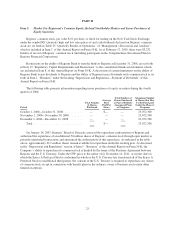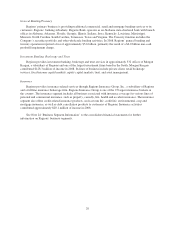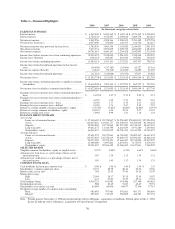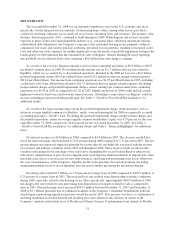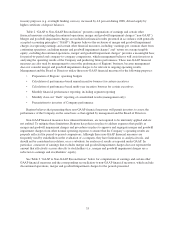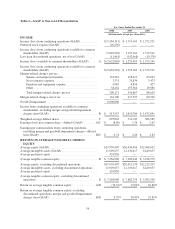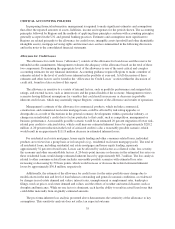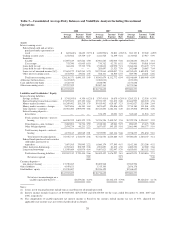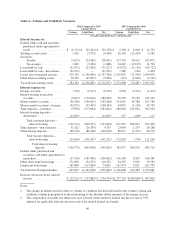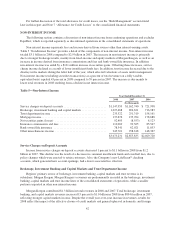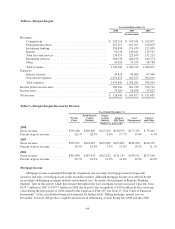Regions Bank 2008 Annual Report Download - page 45
Download and view the complete annual report
Please find page 45 of the 2008 Regions Bank annual report below. You can navigate through the pages in the report by either clicking on the pages listed below, or by using the keyword search tool below to find specific information within the annual report.CRITICAL ACCOUNTING POLICIES
In preparing financial information, management is required to make significant estimates and assumptions
that affect the reported amounts of assets, liabilities, income and expenses for the periods shown. The accounting
principles followed by Regions and the methods of applying these principles conform with accounting principles
generally accepted in the U.S. and general banking practices. Estimates and assumptions most significant to
Regions are related primarily to the allowance for credit losses, intangible assets (goodwill and other identifiable
intangible assets), mortgage servicing rights and income taxes, and are summarized in the following discussion
and in the notes to the consolidated financial statements.
Allowance for Credit Losses
The allowance for credit losses (“allowance”) consists of the allowance for loan losses and the reserve for
unfunded credit commitments. Management evaluates the adequacy of the allowance based on the total of these
two components. Determining the appropriate level of the allowance is one of the most critical and complex
accounting estimates for any financial institution. Accounting guidance requires Regions to make a number of
estimates related to the level of credit losses inherent in the portfolio at year-end. A full discussion of these
estimates and other factors can be found in the “Allowance for Credit Losses” section within the discussion of
credit risk, found in a later section of this report.
The allowance is sensitive to a variety of internal factors, such as portfolio performance and assigned risk
ratings, and external factors, such as interest rates and the general health of the economy. Management reviews
scenarios having different assumptions for variables that could result in increases or decreases in probable
inherent credit losses, which may materially impact Regions’ estimate of the allowance and results of operations.
Management’s estimate of the allowance for commercial products, which includes commercial,
construction, and commercial real estate mortgage loans, could be affected by risk rating upgrades or
downgrades as a result of fluctuations in the general economy, developments within a particular industry, or
changes in an individual’s credit due to factors particular to that credit, such as competition, management or
business performance. A reasonably possible scenario would be an estimated 20 percent migration of lower risk-
related pass credits to criticized status, which could increase estimated inherent losses by approximately $218.2
million. A 20 percent reduction in the level of criticized credits is also a reasonably possible scenario, which
would result in an approximate $111.8 million decrease in estimated inherent losses.
For residential real estate mortgages, home equity lending and other consumer-related loans, individual
products are reviewed on a group basis or in loan pools (e.g., residential real estate mortgage pools). The total of
all residential loans, including residential real estate mortgages and home equity lending, represents
approximately 32 percent of total loans. Losses can be affected by such factors as collateral value, loss severity,
the economy and other uncontrollable factors. A 20-basis-point increase or decrease in the estimated loss rates on
these residential loans would change estimated inherent losses by approximately $61.7 million. The loss analysis
related to other consumer-related loans includes reasonably possible scenarios with estimated loss rates
increasing or decreasing by 50 basis points, which would increase or decrease the related estimated inherent
losses by approximately $30.8 million, respectively.
Additionally, the estimate of the allowance for credit losses for the entire portfolio may change due to
modifications in the mix and level of loan balances outstanding and general economic conditions, as evidenced
by changes in real estate demand and values, interest rates, unemployment or employment rates, bankruptcy
filings, used car prices, real estate demand and values, and the effects of weather and natural disasters such as
droughts and hurricanes. While no one factor is dominant, each has the ability to result in actual loan losses that
could differ materially from originally estimated amounts.
The pro forma inherent loss analysis presented above demonstrates the sensitivity of the allowance to key
assumptions. This sensitivity analysis does not reflect an expected outcome.
35


